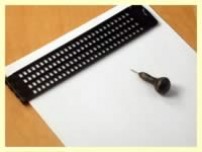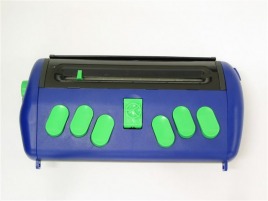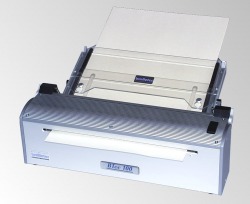Methods for Writing Braille
As the rest of the world has progressed, Braille has also adapted to the changing technology. The original wooden slate and stylus has lead to Braille writers and desktop Braille printers. Here are short descriptions and pictures:
Slate and Stylus

The slate and stylus was, and still is, the main method for writing Braille by hand. Originally, it was simply a sharp tool, a thin wooden board, and a crude dot stencil. It has hardly changed at all since then, other than the materials the slate and stylus are made of.
Ironically, the stylus is much like the stitching awl which caused Louis to become blind.
Ironically, the stylus is much like the stitching awl which caused Louis to become blind.
Braille Writers

Braille writers, or "braillers," are basically typewriters for Braille. The original Braille writer was developed by David Abraham in 1951, for use in the Perkins School for the Blind. Braille writers are usually used for taking notes, or writing letters, stories, and poems.
The machine is either set on a surface or held with both hands. Six finger keys and a "space bar" are used to write. Each key corresponds with a dot in a Braille cell.
Depending on the kind of Braille writer, it may emboss the braille onto paper or read the material back to you.
The machine is either set on a surface or held with both hands. Six finger keys and a "space bar" are used to write. Each key corresponds with a dot in a Braille cell.
Depending on the kind of Braille writer, it may emboss the braille onto paper or read the material back to you.
Braille Printers

Braille printers are really not any different than regular printers, other than the fact that they emboss Braille onto paper rather than printing ink on paper.
Braille printers, scanners, and copiers come in a wide variety of sizes. Most can be connected to a computer and used just like any other printer/scanner/copier.
Braille printers, scanners, and copiers come in a wide variety of sizes. Most can be connected to a computer and used just like any other printer/scanner/copier.
